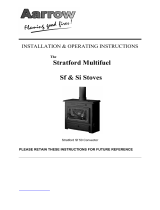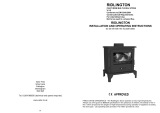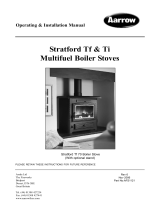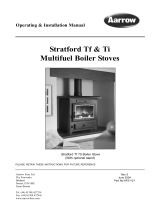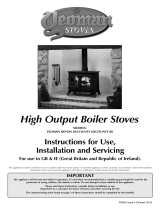
2.4. The chimney
The chimney must be in good condition free from cracks
and blockages and should not have an excessive cross
sectional area. If problems are encountered expert
advice should be sought regarding the necessity of
having the chimney lined. Should it be found necessary
to line the chimney, a lining suitable for solid fuel must
be used. If the appliance is to be fitted in a room where
there is no existing chimney a prefabricated block
chimney or a twin walled insulated stainless steel flue to
B.S 4543 can be used either internally or externally. The
internal diameter must not be less than 150 mm (6
inches). These flues must be fitted in accordance with
the manufacturers instructions and Building
regulations.
Before connecting the appliance to an existing flue, the
flue must be swept and checked. In order for the
appliance to perform satisfactorily the chimney height
should not be less than 5 metres measured vertically
from the outlet of the stove to the top of the flue terminal.
Should there be excessive draught in the chimney it
may be necessary to fit a draught stabliliser.
2.5. Chimney connection
No combustible materials may be set closer than at
least 450 mm clearance.
A 150 mm diameter flue pipe will be required to connect
the stove to the chimney. Make sure the flue pipe is
suitable for solid fuel (cast iron, stainless steel, vitreous
enamelled steel). Under no circumstances should
flexible or asbestos pipe be used.
Too long horizontal smoke pipe may dangerously
restrain the running of the appliance (do not exceed 0,3
m in length). The connecting flue should not exceed 1,8
m in length. Greater lengths should be completed by
using twin-walled insulated chimney.
Ensure the flue pipe extends into the chimney but not so
far that it blocks air flow.
Ceiling or wall penetration should always be made with
insulated pipe and the proper accessories.
Allow fire cement to dry properly before lighting the
stove. Stove running and chimney being hot, check if
chimney draught is at least 10 Pa (1 mm w.g.) at normal
rate and 15 Pa (1,5 mm w.g.) at maximum rate.
If chimney draught is too excessive, a flue stabiliser
should be installed on the flue pipe or on masonry
chimney so as to avoid the introduction of cold air into
the chimney.
2.6. Water connections
With add-in boiler C 22.03.01 or C 22.07.01
FRANCO-BELGE recommends that the installation is
carried out by a qualified heating engineer who is fully
experienced in solid fuel heating installations.
Must be provided (fig. 5) :
-an expansion tank open to the atmosphere,
-an indirect cylinder,
-a gravity circulation to one radiator to dissipate heat
when the pump is off,
-the fitting of a low limit thermostat to the primary return
to ensure the pump does not operate when return
water temperatures are less than 50 ° C,
-a drainage tap in the return flow.
2.7. Check list before lighting stove
-check that all firebox parts (grates, flue baffle and
refractory bricks) are correctly fitted and that the
oscillating grates move correctly when operated
-check the appliance for soundness of seals between
casting (flue collar, blanking plates, loading doors,
etc...)
-check the connection between the appliance and the
chimney flue for air tightness
-check if there is enough water in the heating system
and check the connections for water leaks
-after lighting up the stove, check if it operates correctly
under fire, check for soundness of seals, leave the
appliance operational with the heating system
correctly balanced, hand over user instructions.
2.8. Adjustment of the thermostat
The thermostat has been set in the factory. If it becomes
necessary to make adjustments or fit a new thermostat,
the following procedure should be followed (see fig. 6) :
-ensure the appliance is cold,
-remove the rear metal heat shield,
-set the thermostat adjustment lever at position «8»
(fully open),
-adjust the position of the screw on the lever arm to
provide a gap of 50 mm,
-set the thermostat adjustment lever at position «1»
(fully closed),
-refit the rear metal heat shield.
Notice de référence “316” 5
Lorraine MF/Alsacien - réf. 124 13 01 Installation instructions
Figure 5 - Water connections
Figure 6 - Adjustment of the thermostat
Lever arm
Screw
Damper


















